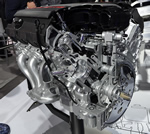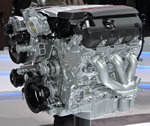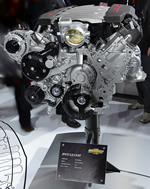Something Wicked This Way Comes: the 2014 C7 Corvette Stingray is Unveiled: Page 8 of 11
The Corvette Action Center takes an up close and personal look at the C7 Corvette and interviews the key players behind it.
by Robert Loszewski
© February 2013
No use without permission, All Rights Reserved
Jake Drennon: Was the original concept to have a smaller package but just as much horsepower?
Jordan Lee: Every time we get the opportunity to do an all new engine, which doesn't happen very often, we get a chance to apply all of our latest and greatest learnings — all of our newest technologies, and our newest analysis tools.
That's why you see on the Gen V, we've got some technology that we were just not ready to introduce on Gen IV. The direct injection, active fuel management on the Corvette, variable valve timing, not to mention all of the other things that we've done with the structure of the block, structure of the head, minimizing unusual, and unpleasant noises, but still keeping that same visceral sound that's so characteristic of small blocks, and all of the fuel efficiency and refinements that go with that.
So it wasn't that the LS was a bad series. It was time to update it, modernize it and refine it using all of the latest and greatest things that we've learned over the years.
Package size is critical for us. Some of our critics in the past say that we stick with the same architecture and why not do double overhead cams?
We know how to do double overhead cams engines really well. We make a lot of them in V6 engines, or four cylinder engines. We do a very good job; probably the best in the industry at making double overhead cam engines.
But for Corvette, the Corvette is such a unique animal. It's a high performance sports car. It relies on a low center of gravity, lightweight, and a very low head line. If you look at a double overhead cam engine, and try to package it under the hood of a Corvette, it's no longer the Corvette that we know and love.
We wanted to try and make sure that the journalists and others outside the industry, really understood why we chose to continue to refine the architecture that we have. So we did a little comparison on the BMW: similar engines, both V8s. They chose a different technology path to get around 400hp. We have a little bit more torque. When you look at their chosen architecture — a double overhead cam twin turbo, which everyone thinks that sounds pretty futuristic and high tech, it's a big, heavy engine.
What we've been able to accomplish with the small block is make more power and torque in a much smaller and lighter package size. That's really critical to Corvette's success. Tadge Juechter relies on us to give him a very compact engine.
We use a term called "power density". How small can you make that package for how much power you can make. We think we're the leaders in the industry. We make the most power and torque in the smallest package possible. That makes the Corvette the great car that it is. It allows for that low head line, that low center of gravity and light mass.
So we choose that architecture and continue to refine it because it does a lot of good things for us.
Jake Drennon: What led to the reversing of the valves?
Jordan Lee: Combustion. It comes down to combustion efficiency, and the way the air enters the combustion chamber. We looked at over 100 different iterations of combustion systems. Reversing the valves was one of the ways that we could get a better symmetry across all of the cylinders and improve that efficiency for the whole combustion system. So even though it was different, and a little bit of a game-changer for us because historically we've always been the other way, there were benefits, and we wanted to make sure that the end result was engine performance didn't suffer.
Jake Drennon: Are there other engines that have been done this way or, is this fresh engineering from General Motors?
Jordan Lee: It's fresh. It doesn't really matter so much what position the valves are in. What matters is how efficiently you get the air in and you get the combustion gases out. So our arrangement works very well for us and it gives us the efficiency we were looking for.
Dan Adovasio: We talked a little earlier about the design of the piston, the top of the piston for better combustion, and that's kind of an unusual look to it. You talked about how many iterations you went through to get to that design.
Jordan Lee: Yes, topography of the piston. We have competitors that do DI engines, and we're very proud of the fact that we think we have some of the best analytical tools and combustion engineers in the industry.
We didn't just develop and throw a DI fuel system on a PFI engine and call it a day. We optimized, and re-optimized and engineered the topography to be very unique in that it mixes the air and fuel completely and it burns the combustion charge very completely.
It sounds simplistic, but mostly because on a global aspect, it is. You've got fuel and air in the engine. If you burn every drop of fuel and everything that's exhausted is already spent, your efficiencies are better. You make better power and torque, and your emissions are much better.
We have a lot of analytical horsepower, a lot of computers and computational time. That entire Gen V engine consumed over ten million hours of CPU time in order to design and optimize that engine. Six million of those hours were spent only on the combustion system. So that gives you an idea of how much we put into that combustion system.
So it looks the way it does all for a purpose; a purposely engineered system to extract as much energy as possible out of each drop of fuel.



